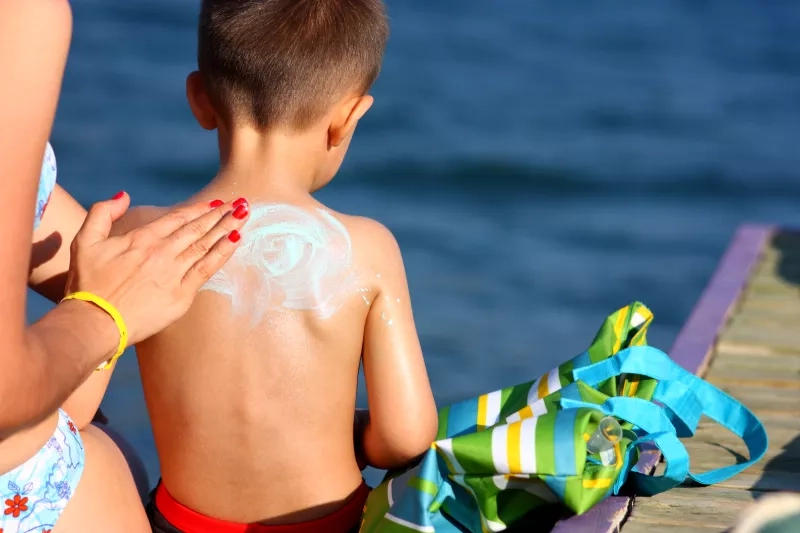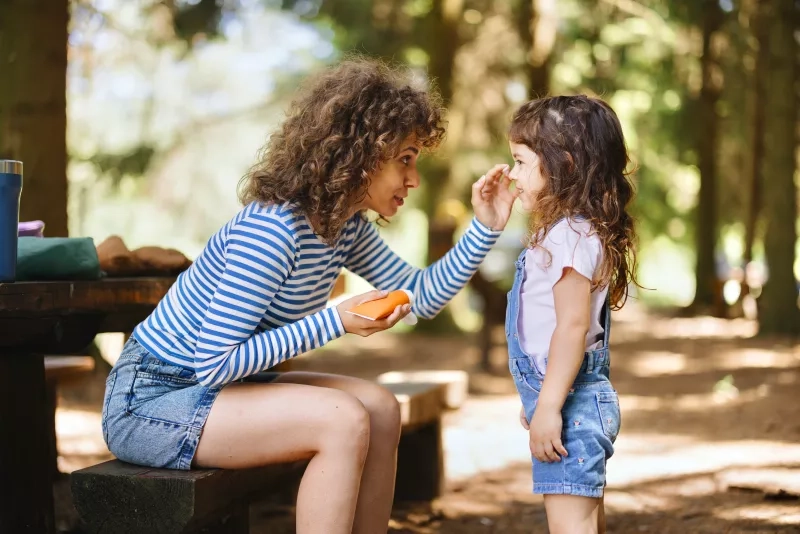
Stay sun safe this summer with these 7 tips
5 Minute Read
Imagine this: you’ve just spent a perfect day at the beach, swimming through the waves and relaxing on the sand. As you drive home, your skin starts to feel tight, dry and hot to the touch—hallmark signs of the dreaded sunburn. Suddenly, your fun excursion has turned into days of discomfort that can only be solved by cool baths, lots of water, and generous amounts of aloe vera.
Fun in the sun doesn’t have to end with a sunburn, one of the leading causes of skin cancer in Canada. Prolonged exposure might even lead to heat illness and sun poisoning, which can be extremely dangerous and may require medical attention.
The good news is that it’s possible to avoid dangerous UV rays without compromising on all the outdoor adventures you’re planning for your summer vacation. Here’s how you can stay sun safe and protect your skin from UV rays.
When you need sun protection
The sun is most dangerous between the hours of 11 a.m. and 3 p.m., when UV rays are strongest. During these times, stay indoors or seek out shady spots. If you can’t find shelter, bring your own—a beach umbrella or tent can provide much-needed shade in direct sunlight. Always remember that the sun can be dangerous even on cloudy days, and that sand, concrete and snow can reflect UV and increase your risk.
A common misconception is that people with darker skin don’t need to worry about the sun, which couldn’t be further from the truth. While light skin is more sensitive, don’t skip out on sunscreen if you have darker skin, because you’re still at risk of skin cancer and other effects.
Some medications increase your sensitivity to the sun, so be extra careful if this applies to you.
Need to buy some portable shade? CAA Members earn four per cent in CAA Dollars at Giant Tiger and five per cent in CAA Dollars at Mountain Warehouse, so that you can pick up a sun shelter for less.
Understanding UV
What is UV, anyway? UV stands for ultraviolet radiation, an invisible form of energy generated by the sun. Some of this radiation is filtered by the atmosphere, but enough gets through to be harmful. There are two main kinds: UVA (can cause immediate tanning and premature wrinkles) and UVB (can cause delayed tanning and sunburn). Both kinds of UV radiation can cause skin cancer.
The best way to understand UV Risk is by looking at the UV Index, which you can find in your local weather report. Anything under two is considered low, whereas you’ll want to protect yourself if the index is three or more. A rating above eight is considered very high, so you may want to stay indoors or cover up more than usual.
Finding the right sunscreen

Sunscreen is one of your best tools to fight sun damage. Look for SPF 30 or higher with a label that says waterproof, water resistant, broad spectrum or sport. Apply a generous amount 15 minutes before you go outside and reapply at least every two hours. It’s easy to forget areas like your nose, neck, shoulders, hands and scalp—pay extra attention if they are exposed. Many lip balms have SPF, so you’ll want to pick up one of those as well.
People with darker skin often worry that sunscreen will make their skin look ashy, but it’s possible to still look and feel your best while protecting yourself. Look for a chemical-based sunscreen rather than a mineral-based product, which will help avoid the white cast that many sunscreens leave behind. There are also plenty of tinted sunscreens out there to match your skin tone.
Well.ca is your ultimate destination for sunscreen, with dozens of options to fit your needs. CAA Members earn three per cent in CAA Dollars when shopping the site. Members also earn at Sephora, Clinique, Vichy and SkinCeuticals, so you can find the best sunscreen for you.
The more coverage, the better
One of the best ways to decrease your risk is by covering up. Hats provide much-needed shade for your face and neck, which often burn first. Breezy long sleeves and loose pants in light colours will protect your skin from the worst of the sun’s rays. For a day at the beach, bring a cover-up to wear when you’re not in the water.
Don’t forget about your eyes, as the sun can damage them as well. For your next long drive or shift outside, pack a pair of sunglasses with UVA and UVB protection. Dark lenses with a gray, green or brown tint will block blue light caused by a glare, offering even better protection. For best results, choose a pair with a close, wraparound fit to reduce stray rays of light.
Did you know you can save when shopping for summer clothes, beach cover-ups and sun gear? Check out Old Navy, Northern Reflections or Reitmans for summery apparel, and have a look at La Vie en Rose or Bikini Village for swimwear. L.L. Bean and Columbia are your go-tos for hats and sunglasses.
Don’t wait until you overheat
The best cure for sunburn or heat illness is prevention. Don’t wait until you feel thirsty to drink plenty of water, and avoid sugar and caffeine, which will dehydrate you. You can snack on hydrating fruits and veggies like watermelon to boost your water intake.
If you start to feel sick from the heat, immediately get out of the sun and cool yourself down with lots of fluids and a cool (not cold) shower or bath. Heatstroke is a medical emergency, so seek help if you or someone else is experiencing extreme symptoms.
Keep babies out of the sun
Babies and young children have sensitive skin, so it’s especially important to protect them from the sun. Any sunburn can be serious for an infant because of their small body mass.
Since babies can’t tell you when they’re too hot, keep them hydrated and in the shade at all times—don't let a baby play in direct sunlight. You should always talk to your doctor before putting sunscreen on an infant under six months old.
Tanning is never safe
All tans cause damage to your skin. Equipment like tanning beds isn’t safer than sun exposure, and they won’t protect you from burning in the future. Products like tanning lotions may seem to prevent painful sunburn, but they do not protect against cancer-causing sun rays. Although many people may think tans look healthy, they are a sign that UV has harmed your skin cells. There is significant evidence that links tanning to skin cancer, premature skin aging, eye damage and more, with the risk increasing the younger you are.
If you want the look of a tan but don’t want the risk, the Canadian Cancer Society considers sunless tanning products like bronzers and spray tans to be safe when applied correctly.
Shop sun protection for less
Sun safety is vital during the summer months and beyond. If you need to gear up to stay out of the sun, CAA Rewards offers savings at many retail partners that can help you protect yourself from harmful exposure, no matter your needs.




